
Stephen J. Ditko was an American comics artist and writer best known as artist and co-creator of the Marvel superheroes Spider-Man and Doctor Strange.
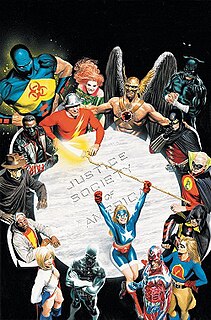
The Justice Society of America (JSA) is a superhero team appearing in American comic books published by DC Comics. The team was conceived by editor Sheldon Mayer and writer Gardner Fox during the Golden Age of Comic Books. The JSA first appeared in All Star Comics #3, making it the first team of superheroes in comic books. The original members of the Justice Society of America were Doctor Fate, Hourman, The Spectre, Sandman, Atom, Flash, Green Lantern, and Hawkman.

The Sandman is the pseudonym of several fictional characters appearing in comic books published by DC Comics. They have appeared in stories of various genres, including the pulp detective character Wesley Dodds, superheroes such as Garrett Sanford and Hector Hall, and mythic fantasy characters more commonly called by the name Dream. Named after the folklore character that is said to bring pleasant dreams to children, each has had some thematic connection to dreaming, and efforts have been made to tie them into a common continuity within the DC Universe.

Power Girl, also known as Kara Zor-L and Karen Starr, is a DC Comics superheroine, making her first appearance in All Star Comics #58. Power Girl is the cousin of DC's flagship hero Superman, but from an alternate universe in the fictional multiverse in which DC Comics stories are set. Originally hailing from the world of Earth-Two, first envisioned as the home of DC's wartime heroes as published in 1940s comic books, Power Girl becomes stranded in the main universe where DC stories are set, and becomes acquainted with that world's Superman and her own counterpart, Supergirl.
Nemesis is the name of two fictional characters in the DC Comics universe. Thomas Andrew Tresser first appeared in The Brave and the Bold #166 and was created by Cary Burkett and Dan Spiegle. Soseh Mykros first appeared in JSA Annual #1 and was created by David S. Goyer and Uriel Caton.

Morgaine le Fey is a character based on St Eurgain, daughter of Welsh King, Maelgwn Gwynedd, who would become a supervillainess published by DC Comics. She debuted in The Demon vol. 1 #1, and was created by Jack Kirby. The character is based on Morgan le Fay, the mythical sorceress and half-sister of King Arthur first made popular in Geoffrey of Monmouth's Vita Merlini.

Paul Levitz is an American comic book writer, editor and executive. The president of DC Comics from 2002–2009, he worked for the company for over 35 years in a wide variety of roles. Along with publisher Jenette Kahn and managing editor Dick Giordano, Levitz was responsible for hiring such writers as Marv Wolfman and Alan Moore, artists such as George Pérez, Keith Giffen, and John Byrne, and editor Karen Berger, who contributed to the 1980s revitalization of the company's line of comic book heroes.

The Creeper is a superhero created by Steve Ditko and Don Segall for DC Comics. He is portrayed as a journalist and talk show host, usually living in Gotham City, who gains the ability to transform into the superhuman the Creeper thanks to experimental science developed by Dr. Yatz. First appearing in Showcase #73, his origin was revised in Secret Origins #18 in 1987, then partially revised again in The Creeper #1-4 in 1997, then completely reimagined in the six-issue miniseries The Creeper, published in 2006-2007.
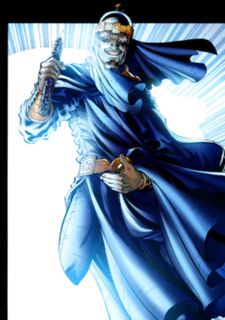
Felix Faust is a supervillain appearing in American comic books published by DC Comics. The character first appeared in Justice League of America #10 (1962), created by Gardner Fox and Mike Sekowsky. He is depicted as an mystic villain connected to the Justice League and its mystic iteration, the Justice League Dark. Commonly portrayed as a malevolent sorcerer obssessed with restoring himself to his former might after being robbed on much of his power during a battle with the Doctor Mist. While typically empowered by the demonic powers of a trio of brothers known as the "Demons Three", whose soul he sold to in a faustian deal, the character also frequently targets other magical entities and objects to strengthen his power, putting him frequently at odds with numerous superhero teams.

Kobra is the name used by two supervillains published by DC Comics. The Jeffrey Burr incarnation of Kobra and his brother Jason first appeared in Kobra #1, and were created by Jack Kirby. Jason Burr debuted as Kobra in Faces of Evil: Kobra #1 by Ivan Brandon and Julian Lopez.

Claw is a sword and sorcery superhero published by DC Comics. He first appeared in Claw the Unconquered #1, in which he was created by writer David Michelinie and designed by artist Ernie Chan.
Sword of Sorcery was an American sword-and-sorcery comics anthology featuring Fafhrd and the Gray Mouser, heroes and rogues created by Fritz Leiber. Published bi-monthly by DC Comics, it ran for five issues in 1973, with a cover price of 20¢. The title was written by Denny O'Neil and featured art by Howard Chaykin, Walt Simonson, and Jim Starlin. The book was cancelled after five issues due to bad sales.
The Huntress, also known as Helena Alfreda Kyle-Wayne, is a fictional superhero appearing in American comic books published by DC Comics. The character is the daughter of the Batman and Catwoman of an alternate universe established in the early 1960s and referred to as "Earth-Two", where the Golden Age stories took place. A modern-day predecessor of Helena Wayne as Huntress with no blood-relation to Batman or Catwoman, Helena Bertinelli, was additionally co-created by the character's co-creator Joe Staton in 1989, originally intended as a reinvention of the character following the events of Crisis on Infinite Earths, before being retconned as different characters.
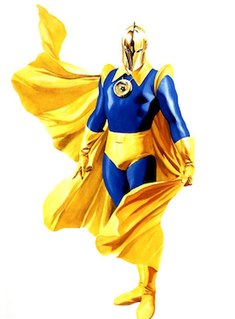
Kent Nelson is a fictional superhero appearing in American comic books published by DC Comics. The character first appeared in More Fun Comics #55 as the initial Doctor Fate originally introduced during the Golden Age of Comic Books and is the most commonly portrayed incarnation of the superhero. The character is commonly portrayed as a agent for the Lords of Order, a group of mystical beings of magic dedicated to protecting the universe from magical threats.

Wotan is a supervillain appearing in American comic books published by DC Comics. The character was created by Gardner Fox and Howard Sherman, first appearing in More Fun Comics #55 (1940). The character is a major antagonist to Doctor Fate and serves as their archenemy.

"Ends of the Earth" is the name of a four-issue comic book story arc written by Gail Simone with art by Aaron Lopresti. Published in issues #20–23 of Wonder Woman vol. 3, it is the third story arc under Gail Simone's writing reigns, following "The Circle" and a two-parter found in issues #18–19. It also marks the return of DC Comics's version of the Beowulf character since his last appearance back in the 1970s.
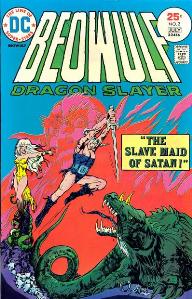
Beowulf is a fictional character of the swords and sorcery genre published by DC Comics. The character debuted in Beowulf: Dragon Slayer #1, and was created by Michael Uslan and Ricardo Villamonte. The character is based on the Anglo-Saxon mythic hero Beowulf, first depicted in the Nowell Codex.

The Huntress is the name of several fictional characters appearing in comic books published by DC Comics, commonly in association with Batman. The two best-known women to bear the Huntress name are Helena Bertinelli and Helena Wayne, the latter being from an alternate universe. Although Helena Wayne and Helena Bertinelli are both superheroes, the Huntress of the Golden Age was a supervillain.
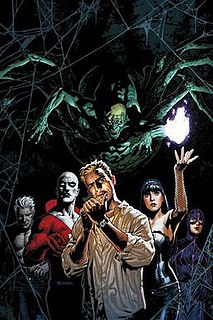
The Justice League Dark, or JLD, is a fictional superhero team appearing in American comic books published by DC Comics. First appearing in Justice League Dark #1, the Justice League Dark originally featured John Constantine, Madame Xanadu, Deadman, Shade: The Changing Man, and Zatanna, eventually being joined by prominent members such as Swamp Thing and Wonder Woman. The team consists of the more supernatural members of the DC Universe, handling situations deemed outside the scope of the traditional Justice League.
















